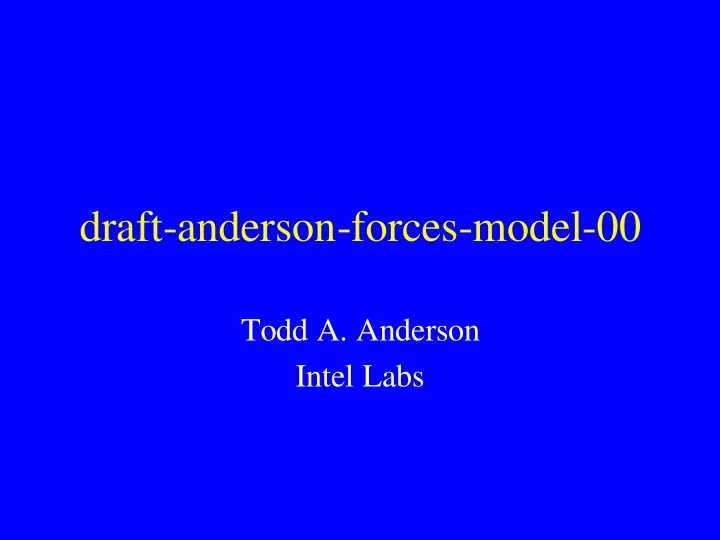

draft-anderson-forces-model-00 Todd A. Anderson Intel Labs
Architecture CE Set CE Set CE CE CE CE … … CE Manager Gc … Gr Gr Gr CE CE Gl Gp FE FE FE Manager … Gf Gi Network Element
Forwarding Element Model • Goal: define a way to express the capabilities of a FE in a manner convenient to CEs. • Solution: use a two level hierarchy. Logical Function “Stage” Level Forwarder Meter Shaper Demux “Capability” Level Classic URL LB Token Leaky L2Proto IPProto 5-tuple IPv4 Switch Bucket Bucket Demux Demux Demux
Stage Level • Gives an overview of what the FE can do in terms of the stages it supports. – Need a namespace for different stage types. • Allows multiples of the same stage in a FE. – Need per stage instance IDs. • Allows the description of arbitrary stage topologies. • Estimate 15-20 kinds of stages.
Capability Level • Describes the detailed abilities of each stage instance. • Uses a uniform methodology across different stages. • Each stage does at most 5 things: – Classifies the packet. – Acts on the result of the classification. – Keeps statistics. – Generates events. – Uses parameters. • Stages can be: – Read-only. – Have default classification/action pairs or parameters. – Have restrictions on allowable values.
Classification Abilities • Variable length sequence of “properties” on which the stage can classify. • Two varieties of properties: – Packet properties (e.g., IPproto, SIP, DIP, TOS) – Metadata properties (e.g., ingress/egress port) • Uses a property namespace.
Action Abilities • Variable length sequence of “actions” that the stage can perform. • Three varieties of actions: – Packet editing (e.g., modify TOS or DIP). – Metadata editing (e.g., set egress port). – Target selection (e.g., send packet to “drop” target). • Uses an action namespace.
Event Abilities • Variable length sequence of “events” that the stage might generate. • Example events: packet redirection, port up/down, forwarding table miss. • Uses an event namespace.
Statistics Abilities • Variable length sequence of “statistics” that the stage maintains as it processing packets. • Example statistics: # of packets processed, # of forwarding table misses. • Uses a statistics namespace.
Parameter Abilities • Variable length sequence of “parameters” used by the stage. • Parameters are the “knobs and dials” of the stage. • Affects how the stage processes packets…not a per packet configuration. • Uses a parameter namespace.
Default Values • Stage capability description must include: – # of default classification/action entries. – # of default properties. – List of TLVs for each classification/action entry. – List of TLVs for each property. • T = one of the namespace “names”. • L = straight-forward. • V = a standard data structure associated with the given name.
Restrictions on Allowable Values • Stages may place restrictions on the values of properties, actions, parameters, statistics, or events. • Solution: – For each ability, the min and max allowable values are specified using the existing TLV approach. – For properties, equality, inequality, and range matching abilities are also specified.
Questions?
Recommend
More recommend